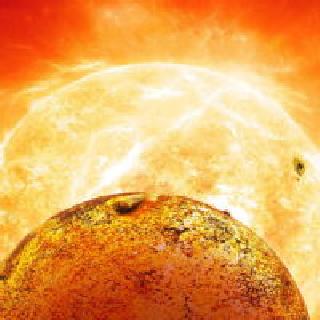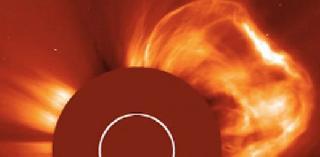
An artistic impression of the planet Kepler-78b. Image credit: Harvard-Smithsonian Center for Astrophysics
WASHINGTON (PTI): Scientists have discovered a new mysterious Earth-like planet - a doomed 'lava world' - with mass and density similar to our planet, orbiting a star 400 light-years away.
The planet Kepler-78b is first known Earth-sized planet with an Earth-like density.
The findings are baffling astronomers because Kepler-78b is a planet that shouldn't exist. This scorching world circles its star every eight-and- a-half hours at a distance of less than one million miles - one of the tightest known orbits.
According to current theories of planet formation, it couldn't have formed so close to its star, nor could it have moved there.
Kepler-78b is about 20 per cent larger than the Earth, with a diameter of 14,806 km and weighs almost twice as much.
As a result it has a density similar to Earth's, which suggests an Earth-like composition of iron and rock.
"Achieving this measurement involved measuring the wobble of a star like the Sun that revolves around its common centre of gravity with the planet at a speed equal to human walking pace. This attests to the exquisite precision of the HARPS-North and HIRES instruments on which the European and US teams carried out their independent, cooperative studies," said Professor Andrew Collier Cameron, of the University of St Andrews, who leads the UK contribution to the project.
The planet orbits a sun-like G-type star located 400 light-years from Earth in the constellation Cygnus.
"Not only is it one of the few confirmed planets with an Earth-like radius and density, but the accuracy of the measurements are close to the best ever achieved from the ground," Professor Don Pollacco, of the University of Warwick, added.
In terms of mass, radius and mean density, Kepler-78b is the planet most similar to the Earth of the exoplanets for which these quantities have been determined.
However, Kepler-78b does differ from Earth, notably in its very short orbital period and correspondingly high temperature.
The planet which tightly orbits a Sun-like star called Kepler 78 is now the smallest exoplanet for which both the mass and radius are known accurately. The tight orbit of Kepler-78b poses a challenge to theorists.
When this planetary system was forming, the young star was larger than it is now. As a result, the current orbit of Kepler-78b would have been inside the swollen star.
A planet cannot form inside a star and it couldn't have formed further away and moved to where it is today as it would have migrated all the way into the star.
Kepler-78b is a doomed world. Gravitational tides will continue to draw Kepler-78b even closer to its star.
Eventually it will move so close that the star's gravity will rip the world apart. Theorists predict that the planet will vanish within three billion years.
The results from two independent teams were published in the journal Nature.
 Next Article
Next Article













The Indian Air Force, in its flight trials evaluation report submitted before the Defence Ministry l..
view articleAn insight into the Medium Multi-Role Combat Aircraft competition...
view articleSky enthusiasts can now spot the International Space Station (ISS) commanded by Indian-American astr..
view article